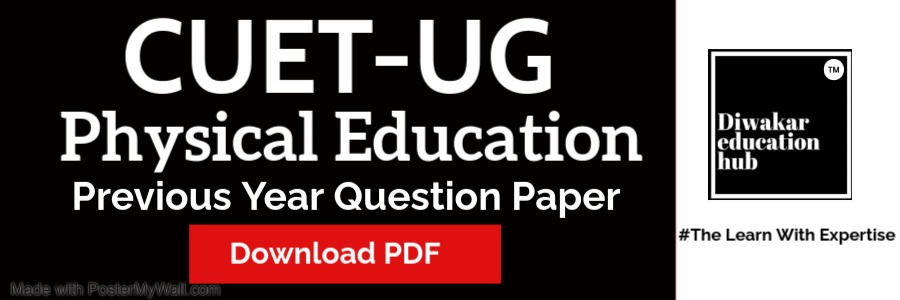CUET UG Physical Education 321 Previous year Question Paper 2021 to 2024

The CUET UG Physical Education (321) exam is a crucial test for students aspiring to pursue undergraduate courses in physical education and sports sciences. Analyzing previous year’s question papers (2021-2024) provides valuable insights into the exam pattern, important topics, and difficulty level. This article offers comprehensive Details of the CUET UG Physical Education (321) previous year papers from 2021 to 2024, helping students streamline their preparation effectively.
Table of Contents
CUET UG Physical Education Previous Year Solved Paper
| Year | Link |
|---|---|
| CUET UG Physical Education Question Paper 2021 | Click Here |
| CUET UG Physical Education Question Paper 2022 | Click Here |
| CUET UG Physical Education Question Paper 2023 | Click Here |
Key Highlights from Previous Year Papers CUET UG Physical Education (2021-2024)
- Topic Weightage
- Physical Fitness & Wellness: Frequently asked questions on health-related fitness and training principles.
- Sports Psychology & Sociology: Questions on motivation, personality, and group dynamics in sports.
- Kinesiology & Biomechanics: Application-based questions on movement mechanics and human anatomy.
- Yoga & Physical Education Trends: Increasing focus on yoga postures, benefits, and government policies.
- Sports Management & Ethics: Case-study-based questions on leadership, team management, and fair play.
- Difficulty Level Analysis
- 2021 & 2022: Moderate-level questions, with more emphasis on theoretical concepts.
- 2023 & 2024: Higher difficulty with practical and case-based questions requiring in-depth understanding.
- Type of Questions
- Assertion & Reasoning
- Match the Following
- Fact-based Direct Questions
- Application-Oriented Case Studies
Benefits of Practicing Previous Year Papers
- Understand question trends and frequently repeated topics.
- Improve time management and accuracy.
- Boost confidence by solving real exam-like mock tests.
Exam Structure and Format
| Exam Component | Details |
|---|---|
| Mode of Exam | Computer-Based Test (CBT) |
| Duration | 45 minutes |
| Total Questions | 50 (Students need to attempt 40) |
| Type of Questions | Multiple-Choice Questions (MCQs) |
| Marking Scheme | +5 for each correct answer, -1 for each incorrect answer |
| Language Medium | English and other regional languages |
Difficulty Level Analysis (2021-2024)
(A) Question Distribution and Difficulty Trend
- 2021 & 2022: More fact-based, theoretical questions
- 2023 & 2024: Higher difficulty with case-based and application-oriented questions
| Year | Easy Questions | Moderate Questions | Difficult Questions |
|---|---|---|---|
| 2021 | 40% | 45% | 15% |
| 2022 | 35% | 50% | 15% |
| 2023 | 25% | 55% | 20% |
| 2024 | 20% | 50% | 30% |
CUET UG 2025 Physical Education (321) syllabus
The CUET UG 2025 Physical Education (321) syllabus covers various topics related to physical education, sports science, and health. Below is a structured overview of the key units included in the syllabus:
Unit I: Health Status and Programmes in India
- Major Diseases and Health Policies
- Communicable diseases: Typhoid, Influenza, Malaria, Dengue, HIV Infection
- Non-communicable diseases: Diabetes, Hypertension, Depression
- Nutritional status: Hypo and Hyper nutrition
- Health Policies and Programmes
- National Health Policies (including Mental Health)
- National Policy on Education
- School health services and midday meal programme
- National Rural Health Mission
- Adolescence Education Programme
Unit II: Psychological and Sociological Aspects of Physical Education and Sports
- Psychological Aspects
- Role of Psychology in Games and Sports
- Interest, Aptitude, and Motivation in sports
- Personality development through sports
- Role of sports in managing emotion, stress, and aggression
- Sociological Aspects
- Socialization through sports and their impact on society
- Impact of caste, class, gender, and differently-abled individuals on health and sports
- Development of leadership qualities through games and sports
Unit III: Theoretical Aspects of Games, Sports, and Yogic Practice
- Basics of Games and Sports
- Athletics, Badminton, Basketball, Cricket, Football, Gymnastics, Handball, Hockey, Judo, Kabaddi, Kho-Kho, Volleyball, Swimming, Table Tennis, Wrestling (candidates to opt for one)
- Key Aspects
- Individual/Team classification
- Indoor/Outdoor categorization
- Number of players, equipment/gears
- Playfield areas
- General rules and interpretation
- Advanced skills and basic strategies of the chosen game or sport
Unit IV: Yoga
- Introduction to Yoga
- Meaning, definition, and origin
- Misconceptions about Yoga
- Streams of Yoga: Jnana, Bhakti, Karma, Raja Yoga
- Ashtanga Yoga
- Yama, Niyama, Asana, Pranayama, Pratyahara, Dharana, Dhyana, Samadhi
- Yoga Practices
- Asanas: Classification, benefits, and contraindications
- Pranayama: Techniques and benefits
- Kriyas: Cleansing techniques
- Meditation and its benefits
Unit V: Nutrition and Athlete’s Care
- Nutrition
- Balanced diet and its components
- Role of carbohydrates, proteins, fats, vitamins, and minerals
- Hydration and its importance
- Athlete’s Care
- Common sports injuries and their management
- First aid in sports
- Rehabilitation and recovery techniques
Unit VI: Policy, Programmes, and Career Options
- Policies and Programmes
- National Sports Policy
- Schemes for promoting sports at grassroots and elite levels
- Role of organizations like SAI, IOA, and NSNIS
- Career Options
- Sports coaching and training
- Sports journalism
- Sports management and administration
- Fitness and wellness industry roles
Unit VII: Skill-Related Physical Fitness
- Components
- Speed, agility, balance, coordination, power, reaction time
- Training Methods
- Drills and exercises to enhance skill-related fitness components
- Assessment and evaluation of skill-related fitness
Unit VIII: Measurement and Evaluation
- Fitness Tests
- Standing broad jump, shuttle run, balance tests, sit and reach flexibility test, sprint tests
- Evaluation
- Conducting and interpreting various physical fitness tests for athletes
Preparation Strategy for CUET UG 2025 Physical Education (321)
To excel in CUET UG Physical Education (321), a structured approach covering all topics while managing time efficiently is essential. Below is a detailed preparation strategy to help you score well.
1. Understand the Exam Pattern & Syllabus
The exam consists of multiple-choice questions (MCQs) with a total of 50 questions, out of which candidates must attempt 40. The marking scheme awards five marks for each correct answer, while one mark is deducted for each incorrect response. The exam duration is 45 minutes, and it is conducted in an online, computer-based format. The syllabus includes topics such as health and fitness, sports psychology and sociology, yoga, and lifestyle, sports training and coaching, and sports policies and national programs.A thorough understanding of the syllabus is necessary before starting the preparation. Candidates should download the official syllabus and make a checklist of topics to ensure comprehensive coverage.
2. Make a Study Plan
The preparation should be divided into three phases:
Conceptual Understanding (First 30 Days)
This phase involves studying two to three topics daily, referring to NCERT Class 11 and 12 Physical Education books, and making detailed notes. Watching educational videos can help in understanding practical aspects such as yoga postures and fitness exercises.
Practice & Revision (Next 30 Days)
Solving previous year papers (2021-2024) is essential to understand the question patterns. Daily practice of topic-wise MCQs will help strengthen conceptual clarity. Revising important sports terms, policies, and rules ensures retention.
Mock Tests & Final Revision (Last 15 Days)
Full-length mock tests should be attempted to improve speed and accuracy. Effective time management is crucial, ensuring that 40 questions can be completed within 40 minutes. Quick revision of formulas, rules, and key points will help in the final days.
3. Subject-Wise Preparation Strategy
Health & Fitness
Candidates should learn about different types of fitness, including cardiovascular endurance, muscular strength, and flexibility. Understanding nutritional components such as carbohydrates, proteins, and fats is essential. Memorizing common sports injuries and first aid treatments is also important.
Sports Psychology & Sociology
This section includes topics such as motivation theories, leadership in sports, and managing emotions like aggression and stress. Understanding the role of gender and social issues in sports is also covered.
Yoga & Lifestyle
Knowledge of various asanas and their benefits, along with different Pranayama techniques, is essential. Candidates should also understand how meditation contributes to mental well-being.
Sports Training & Coaching
Topics such as principles of training, the development of motor skills, and the importance of warm-ups and cool-downs should be covered. Learning the rules and regulations of different games is also necessary.
Sports Policies & National Programs
Understanding the National Sports Policy, Khelo India, and Fit India Movement is crucial. Candidates should also be aware of major sports organizations such as the Sports Authority of India (SAI), the Indian Olympic Association (IOA), and governing bodies of different sports. Knowledge of major tournaments, including the Olympics, Asian Games, and World Cups, is also required.
4. Daily Study Routine
A well-planned daily routine will help maintain consistency in preparation.
- In the morning, new topics should be studied and summarized in notes.
- In the afternoon, topic-wise MCQs should be practiced.
- In the evening, revision and mock test attempts should be prioritized.
- Before sleeping, quick revision of sports policies and game rules will help with memorization.
5. Best Study Materials
Candidates should refer to NCERT Class 11 and 12 Physical Education books. Additional reference books such as Dinesh or Saraswati Physical Education Guide, Arihant CUET UG Physical Education Book, and Oswal CUET Preparation Book will be helpful. Online resources, including educational websites and YouTube lectures, can supplement learning.
6. Tips to Score High
Focusing on high-weightage topics such as health and fitness, training principles, and yoga will help maximize scores. Making flashcards for important terms and policies will aid quick revision. Diagrams and flowcharts can be used to simplify complex concepts. Taking short quizzes regularly will help in tracking progress. Staying updated with recent sports events and policy changes is also beneficial.
Frequently Asked Questions (FAQ) – CUET UG 2025 Physical Education (321)
-
What is CUET UG Physical Education (321)?
It is a subject-specific test for students who want to pursue higher studies in Physical Education and Sports Science through CUET UG. The exam assesses knowledge of sports, fitness, health, training, and national sports policies.
-
What is the exam pattern for CUET UG Physical Education?
The exam consists of 50 multiple-choice questions (MCQs), out of which candidates must attempt 40 questions.
Each correct answer awards 5 marks, while 1 mark is deducted for each incorrect response.
The total duration of the exam is 45 minutes.
The test is conducted in an online (computer-based) mode. -
How should I prepare for the CUET UG Physical Education exam?
Understand the syllabus and exam pattern.
Refer to NCERT Class 11 & 12 Physical Education books for conceptual clarity.
Solve previous year question papers (2021-2024) to understand question patterns.
Attempt mock tests regularly to improve speed and accuracy.
Revise key concepts daily, including sports rules, policies, and terminologies -
Is there negative marking in the CUET UG Physical Education exam?
Yes, one mark is deducted for each incorrect answer, while five marks are awarded for each correct response.
-
When will the CUET UG 2025 Physical Education exam be conducted?
The National Testing Agency (NTA) will release the official exam dates. Usually, CUET UG exams are held in May-June.
| CUET UG Physical Education Syllabus | CUET UG Physical Education Book |
Tag:CUET PG Physical Education Question Paper PDF, cuet ug physical education Book, Cuet ug physical education previous year question paper 2021, Cuet ug physical education previous year question paper 2022, Cuet ug physical education previous year question paper pdf, Cuet ug physical education previous year question paper pdf download, Cuet ug physical education previous year question paper with answer key, Cuet ug physical education previous year question paper with answers, Cuet ug physical education previous year question paper with solutions
